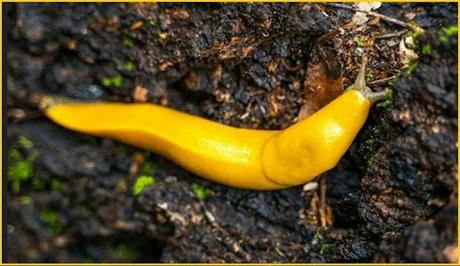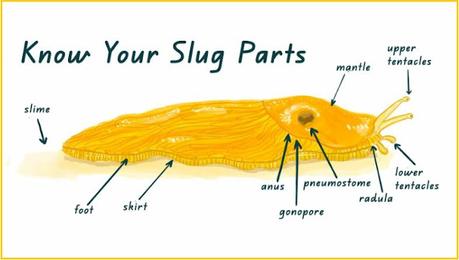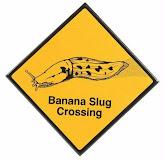The banana slug (genus Ariolimax) is a truly fine citizen of America's western seaboard. It is the second largest species of air-breathing terrestrial gastropod in the world, capable of growing up to a foot long, weighing in at anything up to four ounces (that's 30cm and 115 grams to you newbies) for a mature specimen, and it can live for seven years if it's lucky and doesn't get eaten by the natives.

the magnificent banana slug
It should be obvious why it's called the banana slug, because of its colouring, shape and size, but it actually comes in five varieties and they are not always bright yellow. There's Button's banana slug which looks more like an unripe banana or plantain and is native to California. Then there's the classic California banana slug as pictured above in its bright yellow glory, found in both California and Oregon - as though it's slowly creeping up the coast. The Pacific banana slug is olive green with black spotting and is the most wide-spread of the Ariolimaxes, found anywhere from California through Oregon and up to Washington. The Slender banana slug is bright yellow, but thinner than the California, though central California is also its habitat. Finally there is the Southern Pacific banana slug, also bright yellow, and found as you might guess in the southern reaches of the sunshine state.That list might sound definitive, but the situation is slightly more complicated. What I've described are the default color settings for the five varieties, but all banana slugs are capable of varying their color to an extent, in response to variations in diet, light exposure and moisture levels.
All banana slugs are detritivores, and as such they are vital to the local ecosystem. Their habitat is the forest floor where they happily consume leaves, animal droppings, moss and decaying plant material which they recycle as nitrogen-rich soil humus. The splendid little chaps are thought to have been munching away there since the Pleistocene period some two million years ago.
I sense you're keen to know more, so. here is a handy pictorial guide, followed by some words of enlightenment.

today we have naming of parts
Moving from right to left, at the front end are two sets of retractable tentacles. The longer upper pair are used to detect light and movement, the short lower pair detect chemicals. If a slug loses a tentacle for any reason, it simply grows a new one.Immediately behind the lower tentacles is the radula, the slug's feeding apparatus, a ribbon-like structure covered in rows of microscopic teeth for biting or cutting material before it disappears into the oesophagus.
Up top like a helmet is the mantle, providing a level of protection to the vital components of a slug's anatomy. There is a single lung with an external opening or pore, the pneumostome, through which the slug breathes.
There is a gonopore, where the sexy stuff happens. Slugs are hermaphrodites, possessing both male and female productive organs, allowing them to mate as either sex - or even to fertilise themselves if they happen to be too far from a suitable partner when the urge takes them, though they are capable of traveling at six inches (15 cm) a minute. An impregnated slug will lay anything between ten and fifty eggs in some handy forest floor crevice, but from that moment the incipient offspring are entirely on their own.
The anus, set surprisingly far forward on the gastropod's structure, is where all that splendid processed waste gets excreted to enrich the forest floor. Maybe that's why the giant sequoias of California's redwood forests can grow to over two hundred feet tall!
Of course slugs are invertebrates. They have no skeleton, no spine. Most of the rest of the body is what is termed the foot with its skirt, the muscular and very flexible section housing the guts for which all gastropods (literally stomach-foot from the Greek) are named
And no description would be complete without a mention of slime. It's what slugs are most noted for, that silvery mucus trail they leave in their wake. But slime is actually brilliantly clever stuff. Technically, it's neither liquid nor solid, but a liquid crystal substance. Upon contact with external moisture, this substance is capable of absorbing up to one hundred times its volume in water, resulting in a mucous secretion that works in several ways. It coats the banana slug in a protective barrier against dehydration and harmful pathogens and gives it a beautiful, glossy sheen. It allows the slug to glide gracefully and painlessly across the forest floor. It contains pheromones to alert and attract mates. And it contains chemicals that can numb the tongues of interested predators. (Never lick one!)
All in all, I'd say the banana slug is quite the package, and I would contend its a much more attractive and useful animal than many would give it credit for. I believe Californians are rather proud of their State slug (providing it stays outside in nature where it belongs).
And so to a new poem on topic. It's a bit of a fantastical piece and comes with the caveat that this may not be the final version. Based loosely on a rather despicable true event, in which a friend of a friend tried sprinkling a slug in their living-room with cocaine rather than salt, I give you...
Slugs Drugs Onthe scene - damp Oxbourne Hall deep in Thatcher's heartless reign, squat (illegal occupation, not this stately pile) of principals Terry & Julie, with Waterloo sunset in their eyes, both hoping to make it big in something music or stagewise and pro tem living on daddy's handouts. the plan - typical desultory night of whining, wine and drugs in the great hall (ha ha not so great these days with mildewed walls and that library of wise words mottling on) with no logs for the fireplace and only candles for warmth. A shared space with slugs, lots of them, who love the moist conditions, slimingacross ancestral floors at will. So bored out of their anaesthetised brains, Terry & Julie decide they'll experiment, round a few specimens up with sugar tongs, chalk a magick pentagon on the black coffee table and sprinkle their glossy victims with cocaine. Get them out of their heads, says T. Send them to a happy sparkly death says J. the slugs - writhe in a tangled suppurating mass, scream way above the human audible range,have blinding cosmic visions, go burning to sluggy hell.Terry & Julie stare for a brief while but won't bother to clean up the mess, don't even think it was cruel or a waste of drugs and hate the very thought of tomorrow.

Thanks for reading, S ;-) Email ThisBlogThis!Share to XShare to Facebook
